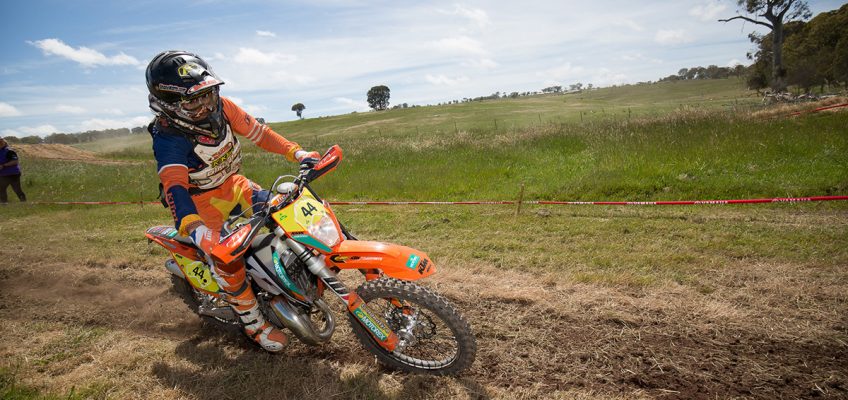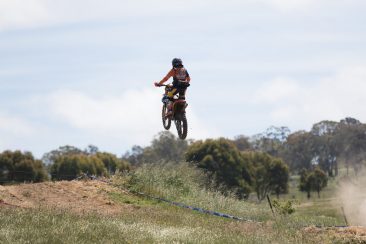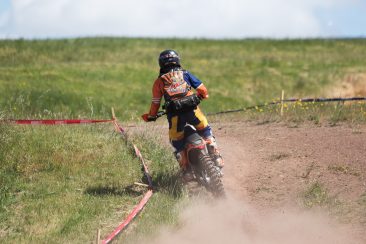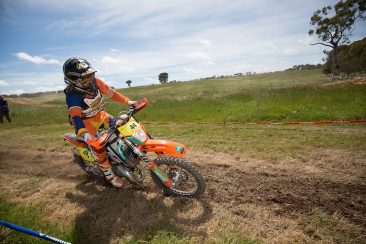Twenty years after becoming Australia’s first World Enduro Champion, Shane Watts climbs back aboard a new-gen KTM 125 XC-W to race the 2016 A4DE.
Words: Andy Wigan // Photos: John Pearson Media, Jeffrey McDonald, Carrie Watts
Twenty years ago, a wild-eyed, cocksure young Victorian called Shane Watts had just won the 1997 125cc Enduro World Championship aboard a prototype version of what soon became KTM’s groundbreaking 1997-model 125 EXC. In doing so, Watts wrote himself indelibly into the history books as Australia’s first ever World Enduro Champion. And tomorrow, the 44-year-old Shane Watts – now living back in Australia after a 16-year stint in the USA – will climb back aboard KTM’s new-generation, 2017-model 125 XC-W to contest the 2016 Australian 4-Day Enduro (A4DE). Fittingly, the nostalgic reunion of man and machine will take place at the 39th running of an event that Shane’s father, Norm, won the inaugural installment of, way back in 1978.
We caught up with the notoriously opinionated Maffra Nugget to get his take on a range of subjects – the most pressing of which seemed to be his impending racetrack rendezvous with KTM’s equally notorious 125cc two-stroke dirt bike…
The revelation that small-bore two-strokes could be Outright race winners…
In 1995 and 1996, in my first two seasons in Europe, I’d ridden a 250cc two-stroke in the Enduro World Championship – where I ran 11th and third, respectively – but the Farioli KTM team guys were insistent that I’d be a good 125 rider and they kept pressing me to race that class in 1997. I always enjoyed riding the 125, but I was uncertain about how successfully I could race the thing. Aside from that, I saw the 250cc class as the premier class, so to win that was like winning the Outright. But then, the day after the final round of the 1996 EWC, [the factory KTM team manager] Farioli convinced me to hang around to test KTM’s all-new 125. It was a prototype version of the model KTM released midway through 1997 – a completely new bike with a radical, no-linkage PDS shock. Anyway, I jumped on the thing and, without even setting it up to suit me, I was immediately 3 seconds per lap faster than my best time on a 250. And the more I rode this 125, the bigger that gap became. That one ride was enough to convince me I’d race the 125 for the 1997 EWC season. The guys from the factory team had obviously seen something in my small-bore riding ability that I hadn’t.
“Being the first Aussie to win an EWC title and the first person to win the ISDE Outright on a 125 are two achievements that no one can ever take away from me.”
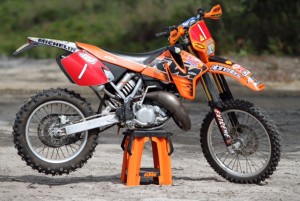 The personal significance of KTM’s 125cc two-stroke…
The personal significance of KTM’s 125cc two-stroke…
The KTM 125 I raced to the world championship win in 1997 was a pre-production unit with sand-cast engine cases and a bunch of other one-off bits. It’s a very special bike that’s kept at my folks’ place now in Victoria; a tangible reminder of an achievement that no one can ever take away from me – being the first Aussie to win an EWC title. I should have also taken that 125 to an ISDE win in Italy that year, but I exploded my ACL in the final moto and ended up DNF’ing the event. After the operation, I tore my ACL again later that year and then tweaked it pretty badly in January, not long before I headed back to Europe. I won a couple of rounds of the ’98 championship, but I sucked at others. And then I exploded my ACL again in Spain – the third time in five months. That spelled the end of my 1998 EWC season. I started riding again in late September, in preparation for the 1998 ISDE (which was in Australia, at Traralgon, that year). I won the 125cc class and the Outright at that Aussie ISDE, and that made me the first guy to ever win the Six-Day Outright on a 125. The following year, I went to America to race the GNCC series. I won four rounds of the GNCC on KTM’s 125, the first two rounds of the EWC back in Europe, and then won a couple more rounds of the GNCC. I then headed back to Australia to race the 1999 4-Day at Welshpool, where I won the 125cc class and Outright, but I obliterated my knee yet again in the final moto there. After a fourth knee reconstruction, I went back to America, won the final two GNCC rounds – again on the 125 – but only finished fourth in the series due to missing a few rounds. In 2000, I managed to win the GNCC title – again, the first Aussie to achieve that. And to make a point about how good all KTM’s EXC models were, I rode five different models on the way to that GNCC title – the 125, 200, 250, 300 and 380cc two-strokes, and the 400cc four-stroke. The 520EXC was the only model I didn’t win on in 2000, though I did take a win on the 520 the following year. I won three of the first five rounds in 2001, but that season was the beginning of the end for me. My burnout had been building for years and I had a mental implosion at Loretta Lynn’s GNCC round. Leading the race, I pulled in for a pit stop, got off the bike and simply walked away. I lost my drive and didn’t put the work in, and pretty much spent the next five years just taking a paycheque.
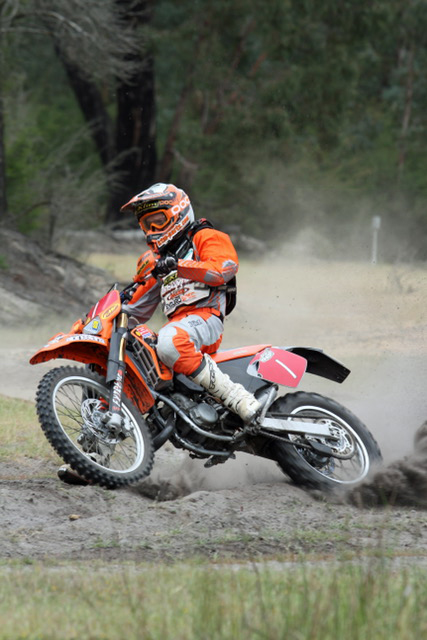 The Australian 4-Day Enduro’s record books…
The Australian 4-Day Enduro’s record books…
I think this year will be the 39th running of the A4DE. My old man won the very first 4-Day at Cessnock, back in 1978, and I believe I still hold the record for the longest winning streak and most Outright wins. I won the 4-Day Outright five years straight – from 1993 to 1997 – and then again in 1999 at Welshpool on the 125, which made it a total of six Outright wins. I believe that Daniel Milner has now won four consecutive 4-Days – from 2012 to 2015 – so both my records could come under threat. After my 1999 4-Day win, I didn’t ride the event again until 2006 at Batemans Bay. That year, I raced KTM’s 200EXC and won the class. Juha Salminen won it Outright aboard KTM’s 250F. AJ Roberts ran second, and I got third, just 3 seconds behind AJ.
The decision to race the 2016 A4DE on KTM’s 125 XC-W…
The last 4-Day I did was 10 years ago, and the last time I raced a 125 at the 4-Day was 17 years ago. Initially, I was planning to ride a 2005-model 200EXC that I’d bought. But then I had a chat with Ben Grabham, who manages KTM’s off-road team, and I suggested to him that I race a 125. When KTM realised their 125 EXC couldn’t meet the new Euro 4 emission regs, the factory decided to make a competition-only version for 2017 – this 125 XC-W. Grabbo liked the idea. He recognised that it could be a good promotional opportunity for the new model. Also, I’m now 44. I’ve barely raced a bike for the past seven years. My timing’s not there. I’m older and slower, and my knees and body are shot, and that affects my confidence in pushing the limits on the bike. As I can ride this 125 harder than other model without the thing beating me up, it’s the perfect bike for the 4-Day. Plus, now that KTM’s 200EXC has been decommissioned, the 125 XC-W is the only small-bore two-stroke in their range. The thing’s torque has come so far, it virtually feels as strong as a 200. I kid you not; it’s that good. For a purebred race bike, it’s hard to top this 125.
The reunion with KTM’s 125cc two-stroke…
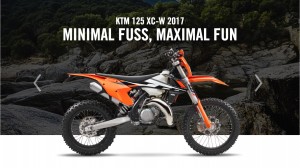 After the GNCC series in 2000, I didn’t race a 125 again. Actually, I did have a 125cc practice bike for a few years and I raced a 125 in a couple of AMA Outdoor rounds in 2000 and 2001 (my best was a 14th at Mount Morris and I actually got given a national race number, 93, for the following year). So I can’t wait to jump back on KTM’s new-generation 125 at this year’s A4DE. This will be just my second Australian 4-Day Enduro in 17 years, so I’m stoked to be doing it on such a great little bike. I mean, KTM’s 125 has always had an incredibly powerful and easy-to-use engine, but this 2017 model is something else. It’s engine, chassis and suspension are all so good and so forgiving, and compared with my ’97 and ’98 125s, the combination of all those little refinements they’ve made over the years has create a machine that feels so sweet and so refined, I can’t stop grinning every time I climb aboard the thing. I really enjoy riding this new 125 because it’s so much fun. And I notice KTM has captured that fun factor in its advertising slogans for the bike.
After the GNCC series in 2000, I didn’t race a 125 again. Actually, I did have a 125cc practice bike for a few years and I raced a 125 in a couple of AMA Outdoor rounds in 2000 and 2001 (my best was a 14th at Mount Morris and I actually got given a national race number, 93, for the following year). So I can’t wait to jump back on KTM’s new-generation 125 at this year’s A4DE. This will be just my second Australian 4-Day Enduro in 17 years, so I’m stoked to be doing it on such a great little bike. I mean, KTM’s 125 has always had an incredibly powerful and easy-to-use engine, but this 2017 model is something else. It’s engine, chassis and suspension are all so good and so forgiving, and compared with my ’97 and ’98 125s, the combination of all those little refinements they’ve made over the years has create a machine that feels so sweet and so refined, I can’t stop grinning every time I climb aboard the thing. I really enjoy riding this new 125 because it’s so much fun. And I notice KTM has captured that fun factor in its advertising slogans for the bike.
“KTM’s 2017 125 XC-W torque has come so far, it virtually feels as strong as a 200. I kid you not; it’s that good. I can’t stop grinning every time I climb aboard the thing.”
Expectations for the 2016 A4DE…
The competitive side of me thinks I’m capable of smashing everyone at the event. But I also understand what reality is [laughs]. I have no chance of beating the top guys in Australia now. Those guys are so awesome. And I no longer have the confidence, skill, precision and desire to try to run with the frontrunners, where the margin for error is so small. I’ve got nothing left to prove, and I love the idea of being healthy enough to ride around with my kids. That’s what I enjoy more these days. So my plan is get out there and have a good, fun ride at the 4-Day. I’ll get on the gas and rip it up here and there, but I’m there for a good time, not to kid myself about winning. I’m sure I’ll feel fast, but get a rude awakening if I compare my Outright times with the top guys. That said, I won’t be hiding in the old boys’ class. I’ve entered E1 and will be happily racing a bunch of really fast, young kids on a 125cc two-stroke that I’m guaranteed to have a ball aboard.
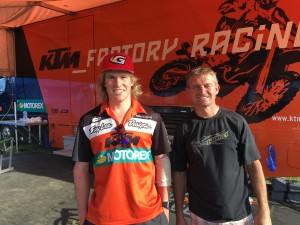 Playing a role in laying the foundations for Australia’s success on the world enduro stage…
Playing a role in laying the foundations for Australia’s success on the world enduro stage…
It’s amazing to see how fast so many guys in Australia are now, and how far they’re willing to push. I like to think that my success in the EWC and ISDE, albeit 20 years ago, has helped break down some barriers and open a few doors for Australian riders in Europe and America. Or, if nothing else, my results simply demonstrated to those guys that it was possible to succeed outside Australia. That gives me a lot of satisfaction, and it’s great to see the level that off-road racing in this country has risen to. Guys such as Stefan Merriman, Daniel Milner, Daniel Sanders, Matt Phillips and Josh Strang and are all exceptional talents who’ve achieved incredible things on the world stage. Whether I was the first Aussie to do well overseas or not, each of those guys still needed the willingness and desire to put the hard yards in and make it happen.
“I like to think that my success in the EWC and ISDE has helped break down some barriers and open a few doors for Australian riders in Europe and America.”
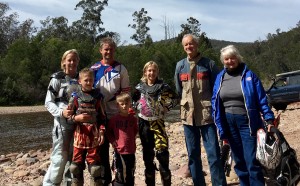
The Watts family’s move back to Australia…
We were looking to move from North Carolina, and Australia was one of our options. And it was what we chose in the end because we wanted our kids to know what Australia was all about and to get to know my family out here. Also, our middle child, Ryan, needed some surgery, which was going to leave us with a hundred-grand worth of out out-of-pocket expenses. With the health care system in Oz, it’s way cheaper here. Then again, we probably spent the best part of 100 grand packing up and moving halfway around the world [laughs]. As much as the surgery for Ryan was the catalyst for moving to Australia, making sure we all experience life in different countries was also part of the decision. That and the fact my wife, Carrie, isn’t stoked on what just went down with the election in the USA.

